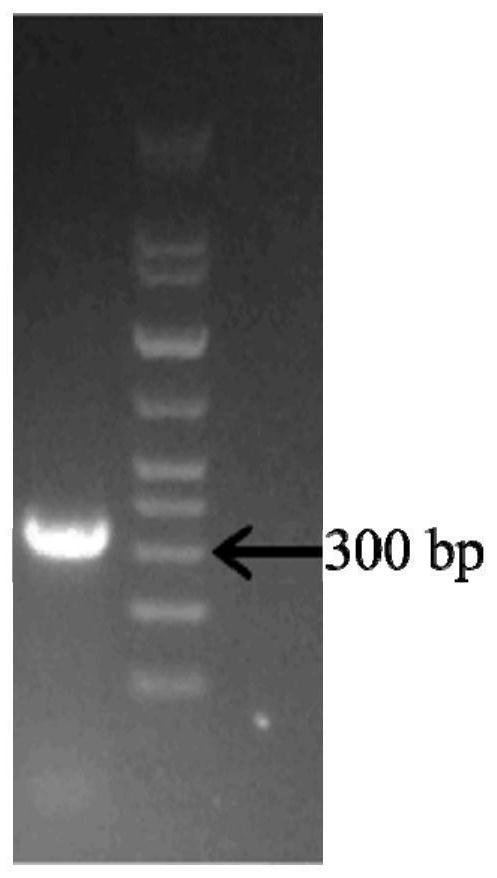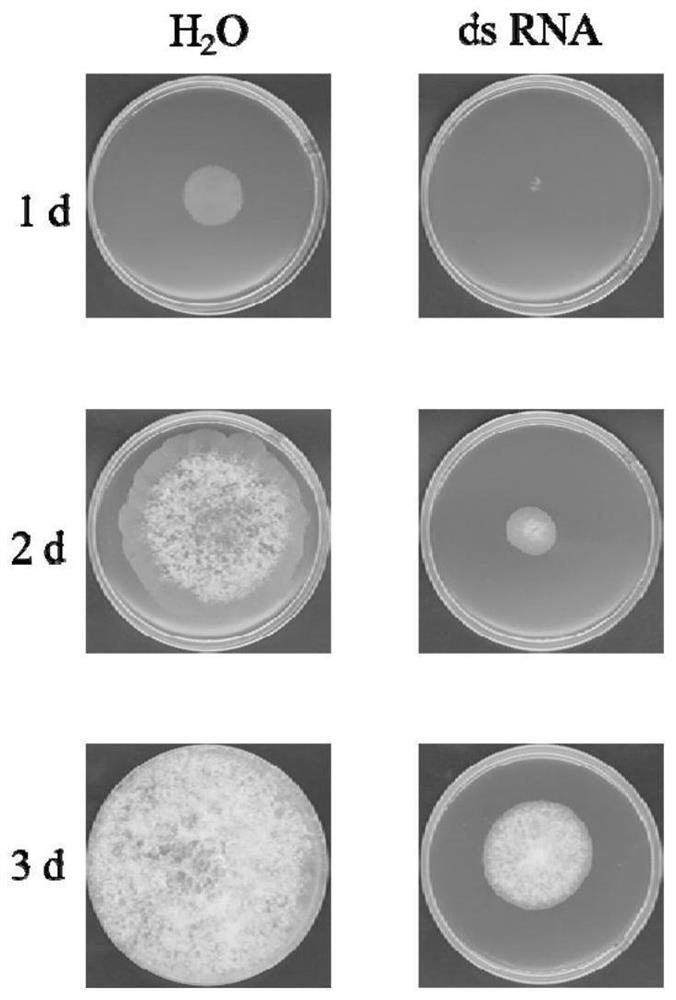DsRNA for inhibiting rhizopus stolonifer and application of dsRNA
A technology of Rhizopus stolonifera and an inhibitor is applied to the dsRNA inhibiting Rhizopus stolonifera and its application field, which can solve problems such as harming human health and producing resistance of microorganisms, so as to alleviate symptoms of soft rot and prevent and control peach soft rot. effect of disease
- Summary
- Abstract
- Description
- Claims
- Application Information
AI Technical Summary
Problems solved by technology
Method used
Image
Examples
Embodiment 1
[0020] Embodiment 1: Obtaining of full-length cDNA and target fragments of Rhizopus stolonifer dcl1 and p450 genes
[0021] The target for preventing and controlling Rhizopus stolonifer consists of the dcl1 gene target sequence and the p450 gene target sequence shown in SEQ ID NO.2. Based on the genome database of Rhizopus stoloniferus, the full-length cDNA sequences of the dcl1 and p450 genes of Rhizopus stoloniferus were searched by biological information method, and the non-conserved region sequences were obtained by the software Snap Gene Viewer , which is the target sequence. According to the target sequence, Primer Premier software was used to design upstream and downstream primers for amplifying the target sequence.
[0022] The primers for amplifying the target sequence are:
[0023] dcl1-F: AGGACCTTGGAGTTGT (SEQ ID NO. 5)
[0024] dcl1-R: AAACATTGGGATTACG (SEQ ID NO. 6)
[0025] p450-F: TCTTACTTGTTGCCAAAC (SEQ ID NO. 7)
[0026] p450-R: GTCGCATAAAGGGAGG (SEQ ID N...
Embodiment 2
[0042] Example 2: Obtaining dcl1 and p450 target sequence dsRNA
[0043] First, the T7 promoter was introduced into the 5' and 3' ends of the target sequence by PCR. After purification, the DNA fragment with the T7 promoter at both ends was used as a template to synthesize dsRNA in vitro using the In vitro Transcription T7 Kit. The specific steps are as follows:
[0044] (1) Configure the following reaction solution
[0045] components Dosage 10×Transcription Buffer 2μL ATP solution 2μL GTP solution 2μL CTP solution 2μL UTP solution 2μL RNase Inhibitor 0.5μL T7 RNA Polymerase 2μL PCR product 20ng~1μg RNase free dH 2 o
Add to 20μL Total 20 μL
[0046] (2) Mix the above solutions evenly and centrifuge slightly, collect the transcription reaction solution at the bottom of the reaction tube, and react at 42°C for 1-2 hours.
[0047] (3) DNase I treatment: after the transcription reaction, 2 ...
Embodiment 3
[0057] Embodiment 3: the application of dcl1 and p450 gene dsRNA in the prevention and treatment of stoloniferous rhizopus
[0058] For dsRNA transcribed in vitro, adjust the concentration to 20ng / μL (use RNase-free water) before use.
[0059] A number of fresh peaches were purchased from Nanjing Zhongcai Vegetable Wholesale Market, and peaches of uniform size and maturity were selected, cleaned, disinfected, and dried in a fume hood.
PUM
 Login to View More
Login to View More Abstract
Description
Claims
Application Information
 Login to View More
Login to View More - R&D
- Intellectual Property
- Life Sciences
- Materials
- Tech Scout
- Unparalleled Data Quality
- Higher Quality Content
- 60% Fewer Hallucinations
Browse by: Latest US Patents, China's latest patents, Technical Efficacy Thesaurus, Application Domain, Technology Topic, Popular Technical Reports.
© 2025 PatSnap. All rights reserved.Legal|Privacy policy|Modern Slavery Act Transparency Statement|Sitemap|About US| Contact US: help@patsnap.com



